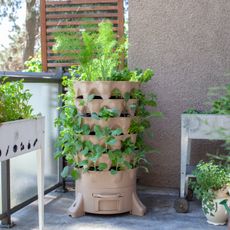Easy Fruits To Grow For Beginner Gardeners


If you are a beginner, knowing some easy fruits to grow can get you on the path to self sufficiency and well being. Growing our own food allows us to control what’s in it, making us healthier. Fruit is one of our main dietary requirements and a pleasure to grow in a home garden.
Fruit Gardening for Beginners
There are many easy-grow fruits to try for novice gardeners. The easiest fruits to grow are often vines or canes. These productive plant structures almost grow like weeds, and often need little special care outside of good soil, proper light, and water. Smaller fruit bushes are also easier to manage than large orchard fruit trees. Consider the soil, light, maintenance level, size, and more when selecting easy fruits to grow at home.
Easy Fruits to Grow at Home
Where you reside will inform some of your fruiting plant decisions. So, too, will the size of the garden, the amount of fruit required, and how much work will be needed to get good harvests. Not everyone can dedicate themselves to the spraying schedule, pruning, and other needs of fruit trees. Sometimes it's better to have a simple plant such as a blueberry that's easy to harvest and provides plenty of plump berries.
Easiest Berries to Grow
It was once the case that blueberries could only thrive in temperate climates. But today’s cultivars have been bred to thrive in higher heat, humid sites, and even dry climates with a little supplemental irrigation. Blueberries are a moderate sized bush but now also come in dwarf forms like Sunshine Blue. They can be grown in garden soil or in larger containers.
Cane berries like raspberry and blueberry are some of the easiest berries to grow. They need feeding in early spring and an average of an inch (2.5 cm) of water per week to fuel those juicy berries. Elderberries and gooseberries are also nice selections. Strawberries are a summer classic and spread over time, creating a nicely sized plot of fruit. Choose an everbearing variety for a long season harvest.
Easiest Fruit Trees for Beginners
The easiest fruit trees for novice growers would be dwarf varieties that have been bred on rootstocks with resistances to the local issues, which might be disease or drought. Whatever issues are prevalent in your area, seek out a tree with resistance to it bred in to make growing the tree more successful.
Many fruit trees take quite a bit of effort to come to fruit. Most will not bear fruit for 3-5 years, so there is some time between planting and harvest. Secondly, they are favorites of many insect pests that destroy the fruit. A dedicated, consistent spraying regimen is necessary to get edible fruit. Another concern is the plant’s pollination needs. Some are self-fruitful and do not need a pollinating partner. Still others will need a fairly close tree as a pollinating partner in order to set fruit.
Gardening tips, videos, info and more delivered right to your inbox!
Sign up for the Gardening Know How newsletter today and receive a free download of our most popular eBook "How to Grow Delicious Tomatoes."
Tips for First-time Fruit Growers
It is not recommended for first time fruit growers to start with trees. Even expert orchard owners find plenty of maintenance, disease, and pest issues with which to deal.
In order to make growing fruit pleasant, low maintenance, and rewarding, choose plants that don’t have high cultivation needs. If possible, select plants that are native to your area. They will have natural resistance to many problems, and be adapted to the native climate.
Smaller fruit plants will blend into the landscape more readily than a tree, and are less expensive ways to start growing fruit. Smaller plants are also easier to protect from wildlife, who enjoy fruit just as much as we do. Select fruit plants that like your native soil. For instance, blueberries need acidic soil. If you live where it is neutral or alkaline, skip the blueberries and opt for a plant that likes those conditions.
Growing Easy
In order to make caring for the new plants simple, here are a few tips:
- Prepare the site.
- Ensure the soil is well draining and amend it with organic matter.
- Use stakes or trellises on taller plants.
- Encourage bees, butterflies, and other pollinators to visit your fruit by planting other flowering plants.
- Use mulch around plants to conserve moisture, and install similar plants with enough space for good air circulation.
- Consider installing drip lines to avoid overhead watering that may cause mildews.
- Feed the plants in spring and along other recommended guidelines for the best chance of healthy plants and bumper crops.

Bonnie Grant is a professional landscaper with a Certification in Urban Gardening. She has been gardening and writing for 15 years. A former professional chef, she has a passion for edible landscaping.
-
 Clever Vertical Vegetable Garden Ideas For Small Spaces – 7 Ways To Save Space
Clever Vertical Vegetable Garden Ideas For Small Spaces – 7 Ways To Save SpaceShort on garden space? Learn some vegetable garden ideas for small spaces that are fun and easy.
By Mary Ellen Ellis
-
 26 Different Types Of Orchids – With Pictures & Information
26 Different Types Of Orchids – With Pictures & InformationDiscover stunning orchid types to grow in your home and garden – from easy beginner varieties to rare and exotic species that are the preserve of experts.
By Melanie Griffiths